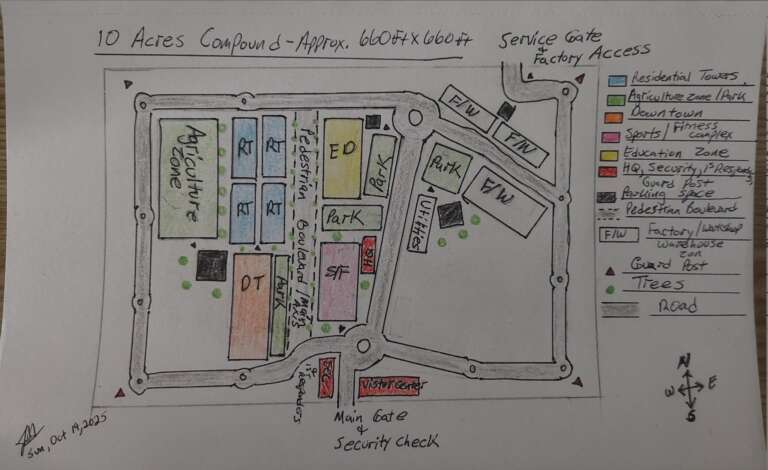Applied Systems Engineering Field Lab (ASEFL)
A TLS Flagship Initiative for Decentralized Infrastructure Research🌍 Overview
The Applied Systems Engineering Field Lab (ASEFL) is a modular research and development hub designed as a living systems testbed to explore how engineering management principles and unmanned systems can be combined to design, operate, and sustain decentralized infrastructure networks.
Developed under The Leopard Society Foundation, Inc. (TLS), ASEFL serves as both a Ph.D. research platform and a prototype model for scalable, network-state-style infrastructure, merging physical field operations with digital twin simulations.
The first site location is TBD, with current feasibility studies underway in the United States, Liberia, and Asia to determine the optimal environment for initial deployment and long-term research scalability.
🎓 Research Focus
Working Dissertation Title:
Engineering Management of Decentralized Infrastructure Systems Using Unmanned Systems and Digital Twin Technologies
Core Research Question:
How can engineering management principles and unmanned systems be combined to design, operate, and sustain decentralized infrastructure networks in developing or forward-operating environments?
⚙️ Key Research Domains
1️⃣ Unmanned Systems Integration
Integration of air, land, and sea unmanned vehicles (UAVs, UGVs, USVs) for logistics, inspection, and communication operations.
Application of engineering management frameworks for hybrid human–autonomous collaboration.
Evaluation of civil and defense use cases, including disaster relief, base support, and remote-area logistics.
2️⃣ Digital Twin & Systems Engineering Management
- Development of a 3D digital twin of the ASEFL compound integrating BIM, GIS, IoT, and UAV-collected data.
- Simulation of logistics, energy, and population systems for predictive management and resilience modeling.
- Creation of engineering dashboards for real-time data visualization and operational control.
🧩 Field Lab Model
Initial Footprint: 10-acre modular campus (expandable to 20 acres).
Construction Approach: Shipping container and steel-frame systems.
Population Capacity: ~300 residents, staff, and research personnel.
Core Facilities: Power generation, communications, education, medical, security, and agriculture units
Digital Twin Node: Linked to a remote HQ (potentially in South Korea or the U.S.) for data visualization and simulation.
🧠 Academic Integration
- Future Degree Goal:
Ph.D. in Engineering Management – Capitol Technology University
(Planned following completion of the M.S. in Acquisition & Contract Management; eligible for up to 18 transfer credits from prior studies.) - In Progress:
B.S. in Computer Science – University of Maryland Global Campus
(Projected Completion: 2026)M.S. in Acquisition & Contract Management – University of Maryland Global Campus
(Expected Start: 2026; Completion: 2027)Graduate Certificate: Project Management (to be earned concurrently with M.S.)
Completed:
A.A.S. in Construction Technology – Community College of the Air Force
15-Year Veteran, U.S. Air Force (3E5X1 – Engineering)
Managed base-level infrastructure planning, engineering operations, and construction project oversight.
Led multi-discipline civil engineering teams supporting U.S. Indo-Pacific Command installations.
Operated and managed the Small Unmanned Aerial Systems (SUAS) program for 3 years, performing aerial mapping, base inspections, and emergency response support.
📊 Strategic Objectives
| Objective | Description |
|---|---|
| Develop Modular Infrastructure Frameworks | Design scalable and resilient physical-digital systems for emerging economies and remote operations. |
| Integrate Unmanned Systems | Leverage autonomous platforms for maintenance, logistics, and environmental monitoring. |
| Build a Digital Twin Ecosystem | Synchronize real-world and simulated environments for predictive management. |
| Train Future Engineers | Partner with universities to provide hands-on systems engineering and field management training. |
| Attract Research Partnerships | Build collaborations across academia, industry, and government sectors. |
🕰️ Project Timeline & Milestones
| Phase | Timeline | Key Milestones |
|---|---|---|
| Phase 0 – Concept & Foundation | 2024–2025 |
• ASEFL master plan developed • 2D site layout & Unreal Engine model • Identification of three potential host nations |
| Phase 1 – Feasibility & Partnerships | 2025 |
• Site evaluation in U.S., Liberia, and Asia • TLS regional partnerships established |
| Phase 2 – Site Selection & Setup | 2026 |
• Final site location chosen • 10-acre lease or land agreement finalized • Initial site preparation and digital twin integration • Initial sponsor and donor commitments secured |
| Phase 3 – Modular Construction | 2027 |
• Core facilities operational (power, comms, housing) • Drone testing and digital twin synchronization • Research and internship program launch |
| Phase 4 – Operations & Research Output | 2028–2029 |
• First research publications • Sponsor showcase and field demonstrations • Ph.D. dissertation completion |
| Phase 5 – Replication & Expansion | 2030+ |
• ASEFL replicated in 2nd location • Open-source framework published • Long-term collaboration network established |
💵 Funding & Sponsorship Opportunities
ASEFL is a 501(c)(3)-aligned research initiative under The Leopard Society Foundation, Inc.Opportunities Available For:
Research & Infrastructure Sponsorship
Equipment & Technology Donations
Academic & Institutional Partnerships
Named Buildings or Laboratories
📧 Contact: jason@theleosoc.com
🌐 Connect & Follow
- Website: theleosoc.com
- Discord: Internal TLS member updates
- Twitter/X: @jasonvonholmes
- LinkedIn: Jason Von Holmes

EMAIL SUBSCRIBE
Sign up with your email address to receive news and updates.

